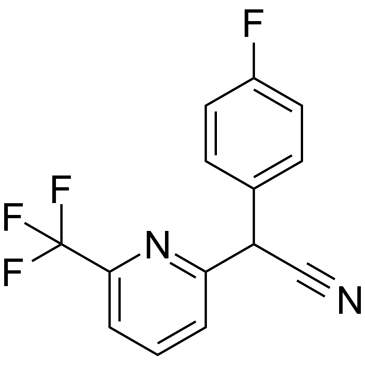Physicochemical Properties
| Molecular Formula | C14H8F4N2 |
| Molecular Weight | 280.220336914063 |
| Exact Mass | 280.06 |
| Elemental Analysis | C, 60.01; H, 2.88; F, 27.12; N, 10.00 |
| CAS # | 1610516-67-0 |
| PubChem CID | 56604881 |
| Appearance | Solid powder |
| LogP | 3.3 |
| Hydrogen Bond Donor Count | 0 |
| Hydrogen Bond Acceptor Count | 6 |
| Rotatable Bond Count | 2 |
| Heavy Atom Count | 20 |
| Complexity | 365 |
| Defined Atom Stereocenter Count | 0 |
| InChi Key | DXQNDKQUHKVTTC-UHFFFAOYSA-N |
| InChi Code | InChI=1S/C14H8F4N2/c15-10-6-4-9(5-7-10)11(8-19)12-2-1-3-13(20-12)14(16,17)18/h1-7,11H |
| Chemical Name | (4-Fluoro-phenyl)-(6-trifluoromethyl-pyridin-2-yl)-acetonitrile |
| Synonyms | ML318; ML 318; ML-318; CID-56604881 |
| HS Tariff Code | 2934.99.9001 |
| Storage |
Powder-20°C 3 years 4°C 2 years In solvent -80°C 6 months -20°C 1 month Note: This product requires protection from light (avoid light exposure) during transportation and storage. |
| Shipping Condition | Room temperature (This product is stable at ambient temperature for a few days during ordinary shipping and time spent in Customs) |
Biological Activity
| ln Vitro | ML318 is a biaryl nitrile inhibitor of PvdQ acylase. ML318 inhibits PvdQ in vitro (IC50 = 20 nM) by binding in the acyl-binding site, as confirmed by the X-ray crystal structure of PvdQ bound to ML318. Additionally, the PvdQ inhibitor is active in a whole cell assay, preventing pyoverdine production and limiting the growth of P. aeruginosa under iron-limiting conditions.[1] |
| References | Identification of inhibitors of PvdQ, an enzyme involved in the synthesis of the siderophore pyoverdine |
Solubility Data
| Solubility (In Vitro) | DMSO : ~100 mg/mL (~356.86 mM) |
| Solubility (In Vivo) |
Solubility in Formulation 1: 2.5 mg/mL (8.92 mM) in 10% DMSO + 40% PEG300 + 5% Tween80 + 45% Saline (add these co-solvents sequentially from left to right, and one by one), suspension solution; with sonication. For example, if 1 mL of working solution is to be prepared, you can add 100 μL of 25.0 mg/mL clear DMSO stock solution to 400 μL PEG300 and mix evenly; then add 50 μL Tween-80 to the above solution and mix evenly; then add 450 μL normal saline to adjust the volume to 1 mL. Preparation of saline: Dissolve 0.9 g of sodium chloride in 100 mL ddH₂ O to obtain a clear solution. Solubility in Formulation 2: 2.5 mg/mL (8.92 mM) in 10% DMSO + 90% (20% SBE-β-CD in Saline) (add these co-solvents sequentially from left to right, and one by one), suspension solution; with ultrasonication. For example, if 1 mL of working solution is to be prepared, you can add 100 μL of 25.0 mg/mL clear DMSO stock solution to 900 μL of 20% SBE-β-CD physiological saline solution and mix evenly. Preparation of 20% SBE-β-CD in Saline (4°C,1 week): Dissolve 2 g SBE-β-CD in 10 mL saline to obtain a clear solution. Solubility in Formulation 3: 10% DMSO+40% PEG300+5% Tween-80+45% Saline: 2.5 mg/mL (8.92 mM) (Please use freshly prepared in vivo formulations for optimal results.) |
| Preparing Stock Solutions | 1 mg | 5 mg | 10 mg | |
| 1 mM | 3.5686 mL | 17.8431 mL | 35.6862 mL | |
| 5 mM | 0.7137 mL | 3.5686 mL | 7.1372 mL | |
| 10 mM | 0.3569 mL | 1.7843 mL | 3.5686 mL |
